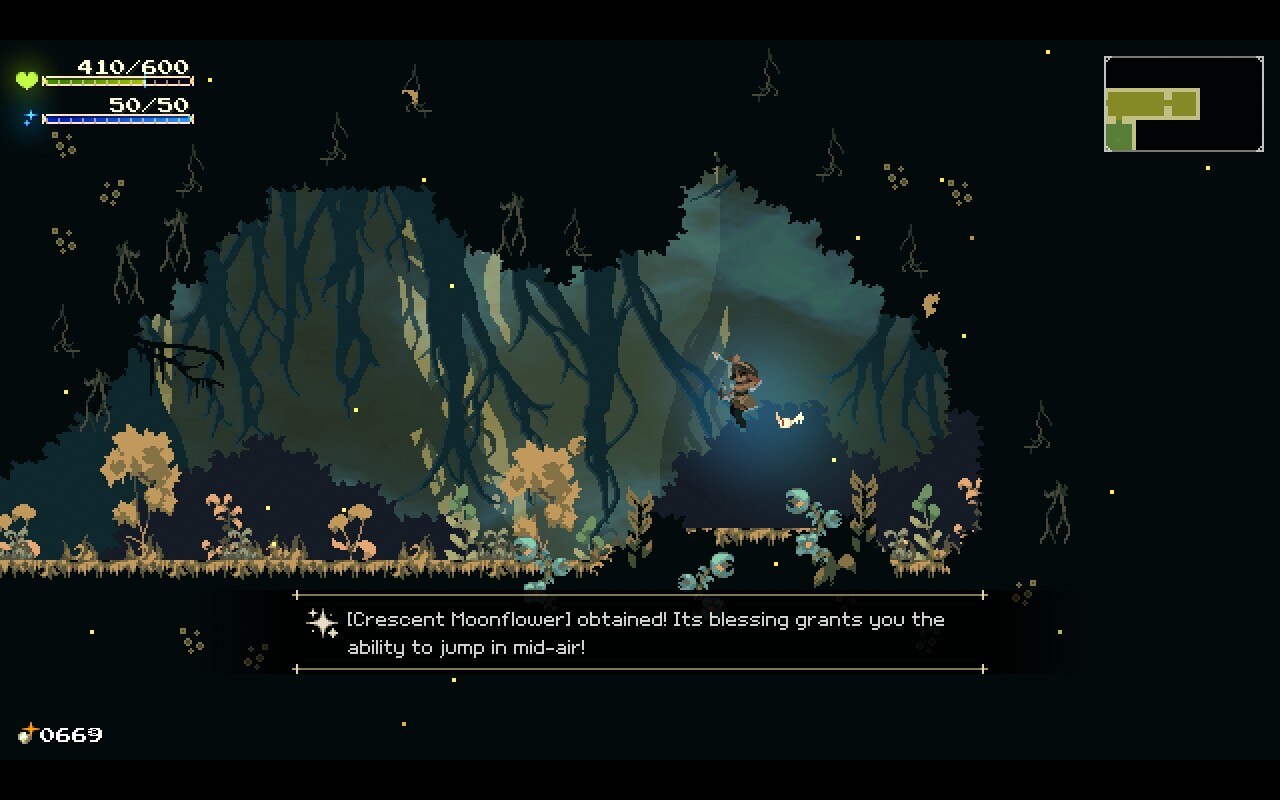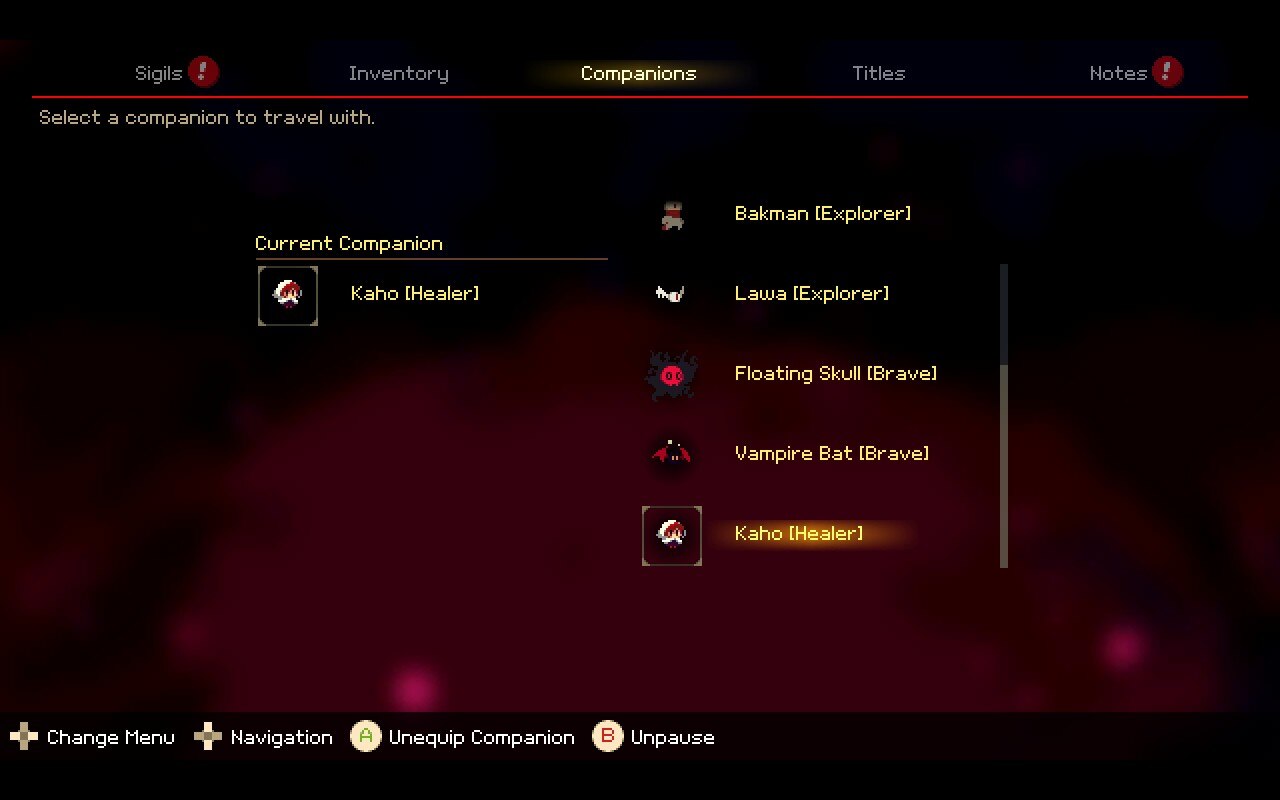
Momodora: Moonlit Farwell is the video game equivalent of a mild Spring day. Entering its world feels both warm and familiar. Everything looks beautiful. Much like a gentle breeze, it pushes you forward at an even pace while later offering just enough resistance to keep things interesting. I enjoy Spring days and I enjoyed this latest, perhaps final installment in the Momoverse. However, both of these things exist in between the extremes of their colleagues, and as a result, don’t leave the strongest impact possible. Both are still worth appreciating though, especially since they’re gone before you know it.
If the above comparison seems a little pretentious, then rest assured that the game at least is not. Moonlit Farewell executes the tried and true exploration-focused platforming formula without any major gimmicks or deviations. What you see is what you get, which works well enough but hampers its ability to be a grand conclusion.
Although it happens to be the fifth Momodora game, I (and I suspect most people) got into the series with its immediate predecessor, Reverie Under the Moonlight. That game tinged its pleasantness with a distinctive sense of foreboding, further enhanced by its nature as a relatively standalone prequel. While Moonlit Farewell retains a similar visual style to Reverie, its threatening sense of the unknown appears notably diminished. This change comes across in the details of its visual design as well as its nature as a more direct continuation to the rest of the series. Put simply, Moonlit Farewell doesn’t expand on a lot of the more subtle charms of its immediate predecessor. Instead, it opts to be more inviting in its tone in order to presumably welcome newer players while also better tying the entire series together as a coherent whole.
The more straightforward nature of the game becomes especially apparent in its level design. Moonlit Farewell features a somewhat open-ended, explorable map in the style of Metroid, but it’s a simple one. Most areas avoid becoming too labyrinthine or expansive. Few paths branch out in meaningful ways and the secrets in those branches are often easy to spot. You won’t get lost often or possibly even at all on this adventure. Instead of exploring a giant interconnected world, traversing Moonlit Farewell feels more like a loosely connected linear series of levels.
As the sense of exploration takes the backseat, it leaves room for the real driver to give the game a powerful sense of momentum. Each area avoids overstaying its welcome before propelling you into the next one. This type of map design evokes that of the legendary Cave Story – one of Momodora’s most obvious inspirations, especially early in the series. Both Moonlit Farewell and Cave Story use their interconnected map more as a backdrop, something to make the game world feel more like a place than being the point of the game.
Action drives Moonlit Farewell forward more than anything else. Of course, “action” may be the most ill-defined term in gaming, so I’ll define it here as how you interact with the enemies. Hostile monsters litter the environment, adding a sense of tension to an otherwise uneventful trek. Even if some of these foes may not seem like much, they can hit surprisingly hard; carelessly running forward will send you back to a checkpoint quickly. The fun of Moonlit Farewell largely comes from your approach: how you choose to fight an enemy, when you choose to avoid them, and how you manage your health before you reach the next checkpoint.
Fighting relies on your ability to strategize. Momo can use a leaf for melee attacks or a bow and arrow for ranged attacks. The challenge in fighting comes from how enemies are positioned; it’s not always safe or convenient to rush headlong into an enemy. Depending on the scenario you can end up surrounded or otherwise in a bad spot. A well-timed dodge roll can solve some of your problems, but not all of them. You need to read your environment carefully to execute your foes in the most efficient way possible, sometimes skipping them entirely if it proves too much of a hassle.
Running isn’t always an option. Occasionally, barriers will trap you into what are essentially “combat rooms” where waves of enemies spawn in. These encounters prevent you from planning things out too carefully, forcing you to quickly identify a solution, essentially testing your knowledge. Bosses of course represent the biggest unavoidable skill check, featuring bigger health bars and more complex attack patterns. Many of these encounters dole out challenge and spectacle in equal measure – they’re easily the highlight of the game. While the “action” never gets overly complex or difficult, it kept me engaged throughout my entire breezy six hour playthrough.
Should the challenge prove too taxing, Moonlit Farewell offers a surprising number of subsystems to ease your burden. I enjoyed the Sigil system the most: you can collect a variety of cards to equip and grant your character special buffs. You can create some impressively broken combinations here. For example, one allows you to create a barrier whenever you heal, essentially giving you an extra free hit on top of your health refill. When you combine that with some extra effects to quickly recharge your magic, it results in nigh invincibility.
Things like the companion system saw less use. Throughout the game you can find various critters to follow you around that will occasionally activate a special effect. They look cute, but sadly I found their uses to be limited and unexciting. Some help slightly in combat while others will drop resources like money, which you’ll get more than enough of anyway. The system comes across a little half-baked; something to use more for the admittedly fun visual of the idea than as a legitimate gameplay mechanic.
In a way, the companion system summarizes how I felt about Moonlit Farewell as a whole. It looks good and I’m glad I experienced it, but it didn’t push itself as far as I expected. It’s a straightforward game that executes what it sets out to do in a relatively straightforward manner. Moonlit Farewell settles for being perfectly pleasant the whole way through. I suppose when it comes to saying goodbye, that’s not so bad.
Momodora: Moonlit Farewell
Good
Momodora: Moonlit Farewell displays a quiet confidence that’s easy to appreciate. It executes on its straightforward design sense effectively and without deviation. As a finale that goal may come across as a little complacent, but it still makes for a perfectly pleasant Spring day.
Pros
- Solid action-first design
- Wonderful pixel art
Cons
- Noticeably restrained
- Some subsystems feel superfluous




